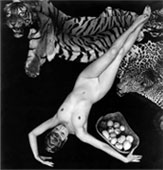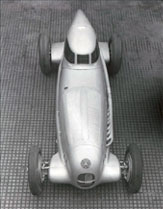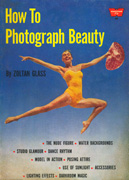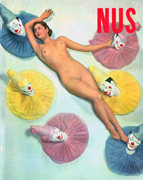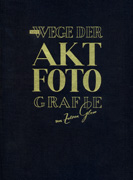
Zoltan began his career as a cartoonist and retoucher for a local newspaper, but in 1925 he moved to Berlin. Initially he earned his living as a freelance jack-of-all-trades. Eventually he found regular employment as the picture editor of a Berlin evening paper, the 5-8 Uhr Abendblatt, and then, from 1931, as a photojournalist on the more important daily, the Berliner Tagblatt. (Interestingly, two other Hungarian-Jewish newspapermen from Budapest who learned their craft on Berlin journals at that time were the writer Arthur Koestler and the cartoonist Victor Weisz, better known later as Vicky of the Daily Mirror and London's Evening Standard.)
As a member of the network of highly talented Hungarian émigrés active in the creative life of the German capital, Glass prospered and was soon able to develop a thriving business as a freelance commercial photographer and journalist. In due course he established Reclaphot, a photographic agency that specialised in advertising work, and Autophot, a company dedicated exclusively to automobile photography.
Already a keen motorsport enthusiast and amateur racer, Glasscovered most of the big races held in Germany between 1931 and 1936,at the Nurburgring and the Avus circuit near Berlin. His photos recording the success of the Mercedes-Benz team received immediate and widespread public acclaim and helped establish the iconography of German technological achievement.
Glass's motoring work also included documentary and reportage photographs taken at car shows and factories, plus publicity shots commissioned by clients such as Daimler-Benz, Auto Union and Shell. As a result, he developed strong personal friendships with a number of leading figures in the Berlin advertising world, including Peter de Peterson of the J Walter Thompson agency.
Working at the centre of a network of American-owned agencies thatlinked the major cities of Europe and North America and transcended normal political boundaries, de Peterson was able to help his friend escape Germany when Nazi persecution of the Jews became intolerable. From early 1936, Glass found himself being excluded from employment by the media and was dismissed from his regular assignments for the Berliner Tagblatt. He decided that, with de Peterson's assistance, he would base himself in London while continuing to run his photo-agencies in Berlin as best as he could.
Following Kristallnacht in November 1938, however, the Nazis introduced laws preventing Jews from owning or running any form of business, and Glass's relationships with Mercedes, Auto Union and other clients were terminated. He was forced to flee Berlin altogether, taking with him his entire collection of negatives.
Fortunately, de Peterson was able to arrange an immigration permit allowing him to settle in London, where he was given work by another Jewish refugee, Arthur Sringarn, owner of Sackville Advertising in Sackville Street, W1.
In addition to his work for newspapers such as the Daily Mirror, he also received commissions from popular magazines such as Life and Picture Post, which published 39 of his stories between 1940 and1941 alone; its editor was Stefan Lorant, another Hungarian emigre, who made an enormous contribution to the development of magazine publishing.
After the war Glass took up British nationality, but the immediate post-war years were a difficult time for all commercial photographers and he was forced to eke out a living taking publicity stills for clients in the film and theatrical worlds. It was not until the early Fifties that he got back on his feet professionally, having teamed up with Arpad Elfer, another Hungarian who worked in advertising in Berlin before the war.
As Creative Director of Colman, Prentis & Varley, one of the most prestigious and innovative of the London ad agencies, Elfer had a string of blue-chip contracts.
Most of this material relied heavily for its impact on Glass's original and inventive photographic ideas. As in his earlier motoring photography, his technique involved the use of oblique camera angles, dramatic lighting and over lapping multi-exposures. The discreet and tasteful employment of scantily-clad models added a new dimension.
By the mid-Fifties, having established Zoltan Glass Studios at 183, Kings Road, Chelsea, and later at Paradise Walk, SW3,"Zolly" (as he was usually known) had consolidated his reputation as one of the most successful fashion and advertising photographers in London. Very much an entrepreneur, he had also developed a novel arrangement by which young, aspiring photographers could use the facilities at his studios free of charge, paying him a percentage of their income by way of rent: many celebrated photographers began their careers in this way.
Odhams Press was another CPV client. It published Lilliput, a pocket-sized gentleman's magazine that featured an assortment of titillating articles and risqué humour, together with adventurous photographic essays from such respected talents as Bill Brandt and Brassai.
Working jointly with Elfer, Glass produced many photo-stories for Lilliput between 1948 and 1956, all exhibiting the light and humorous reportage style he had made his own.
In view of Glass's earlier interest in car photography, it seems odd that he never became involved in British motorsport. The only post-war photo in the exhibition that depicts a car shows a naked female model posing with a 1961 Mercedes 300 SL Gullwing Coupe, a study of the type customarily published in motor-industry calendars.
As a result of his activities for Lilliput, he began to concentrate on what was then known euphemistically as naturist photography. From 1953 he built up a clandestine, parallel, business producing arty, erotic nude studies. It was during this period he photographed the model Pamela Green.
By 1964 he had made enough to sell his Chelsea studio to a consortium
of British photographers and move abroad to a villa at Roquebrune on
the French Riviera with his common-law wife Pat, a former cabaret dancer.
He offered his collection of pin-up photography to Harrison Marks, who
strangely turned him down. He died in France on February 24, 1981, at
the age of 78, leaving neither offspring nor a will.
Based on an Telegraph article by John Reynolds, © 2001
